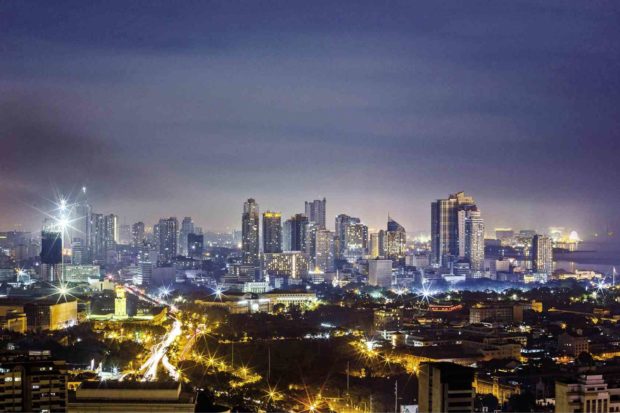Gov’t scraps ‘alarmist metric’ in COVID alert level system

Metro Manila skyline at night (INQUIRER FILE PHOTO / JILSON SECKLER TIU)
MANILA, Philippines — Outgoing Health Secretary Francisco Duque III said on Tuesday that the two-week positive growth rate has been scrapped as a gauge in determining the country’s alert level system, calling it an “unnecessary and alarmist metric.”
“The two-week growth rate has lost its significance [and] relevance, and I think it’s an alarmist metric… and it’s unnecessary. So we, the NVOC (National Vaccination Operations Center), IATF and experts reached a consensus to remove the two-week growth rate,” Duque told reporters in a media forum at a hotel in Manila.
The remaining indicators would be the average daily attack rate (Adar), or the proportion of a population in a given area that contracted the virus, as well as the healthcare utilization rate (HCUR) as these were the “two most accurate measures” of the COVID-19 situation, Duque said.
He cited instances in some areas that posted a 300-percent growth in COVID-19 infections just because cases went from zero to three during a given period.
The revision of the metrics would most likely bring some areas in Metro Manila back to “low risk,” he said.
The Department of Health (DOH) classified over the weekend the cities of Quezon, Pasig, Marikina, and San Juan as well as the municipality of Pateros under “moderate risk.” The rest of the cities in the region remain at low risk.
The health chief added that for an area to be tagged as moderate risk, its Adar should be above 6 and below 18 per 100,000 population, and its HCUR should be within 50 to 70 percent.
Alert Level 1 extended
Meanwhile, the Inter-Agency Task Force for the Management of Emerging Infectious Diseases (IATF) on Monday approved the extension of alert level 1 over Metro Manila, and 85 provinces and major cities from July 1 to 15.
A total of 166 component cities and municipalities were also placed under the least restrictive quarantine level for the same period.
Placed under alert level 2 were 36 provinces, excluding the cities and towns that are among the 166 already under alert level 1.
These are Benguet, Ifugao, Quezon, Occidental Mindoro, Palawan, Camarines Norte, Camarines Sur, Masbate, Antique, Negros Occidental, Bohol, Cebu, Negros Oriental, Leyte, Northern Samar, Western Samar, Isabela City, Zamboanga del Norte, Zamboanga del Sur, Zamboanga Sibugay, Lanao del Norte, Davao de Oro, Davao del Norte, Davao del Sur, Davao Occidental, North Cotabato, General Santos City, Sarangani, Sultan Kudarat, Dinagat Islands, Surigao del Norte, Basilan, Lanao del Sur, Maguindanao, Sulu and Tawi-Tawi.
But health experts warned that COVID-19 cases could pick up in the coming days, with Health Undersecretary Maria Rosario Vergeire projecting national daily infections to rise to 5,300 cases in two weeks and 22,000 in a month if mobility continued to increase and booster coverage remained low.
Citing projections from the DOH’s Feasibility Analysis of Syndromic Surveillance using Spatio-Temporal Epidemiological Modeler, new daily cases could reach as high as 5,362 by July 15 if compliance with minimum public health standards such as masking and physical distancing was reduced by 22 percent.
By the end of next month, daily cases could jump to 22,187 under the same scenario if health protocols were shunned, mobility restrictions remained relaxed and booster rates slowed.
Mid-September peak
Separate forecasts from the Australian Tuberculosis Modelling Network showed that a peak in new cases in Metro Manila by mid-September could reach 1,784 if capacity of in-person classes would go up by 90 percent when the next school year opens in August.
COVID-19 cases continued to rise in all regions in the past week, but severe and critical infections remained below 1,000, Vergeire said.
Guido David, a fellow of the University of the Philippines-based Octa Research, said COVID-19 cases in Metro Manila could reach as high as 500 daily after the positivity rate rose to 6 percent, or more than the 5-percent recommended benchmark of the World Health Organization.
However, he said such an increase in the daily case count was not a cause for worry yet.
‘We expect [Metro Manila’s daily cases] to possibly reach, maybe between 400 [and] 500 this week. Actually, it was 434 cases [on Monday] but we can reach up to around 500 a day, but this is not worrying because the number is low compared to the previous surge,” David said in an interview during the televised Laging Handa public briefing.
He noted that the one-week growth rate in Metro Manila was already at 52 percent while the seven-day average was 342 cases.
RELATED STORIES
Metro Manila’s COVID-19 cases may rise to 500 a day this week — Octa
DOH projects up to 4,600 COVID-19 daily cases in NCR by mid-July































